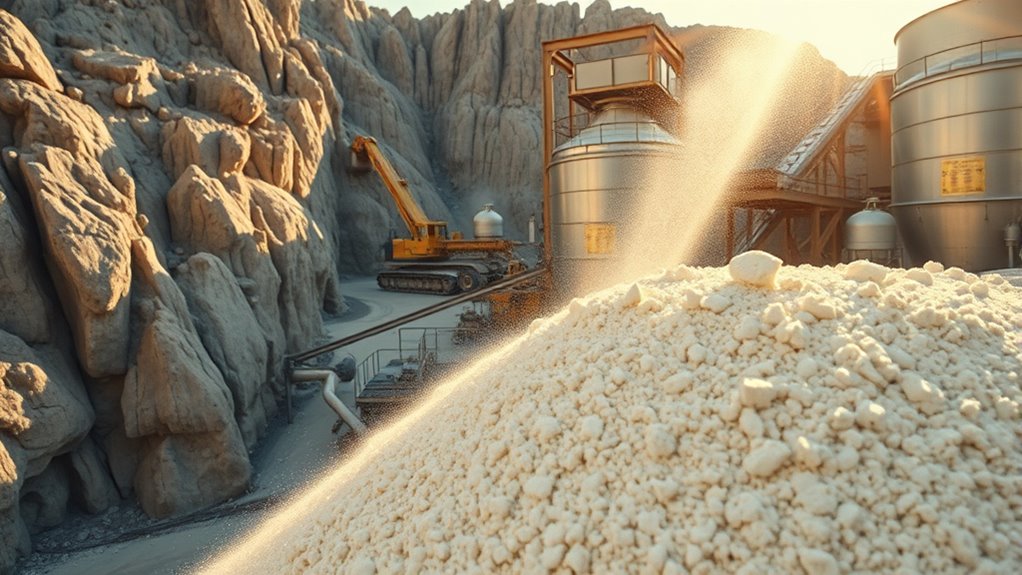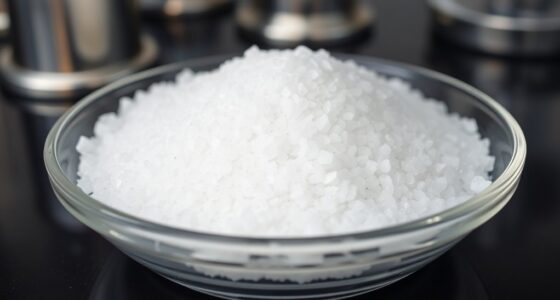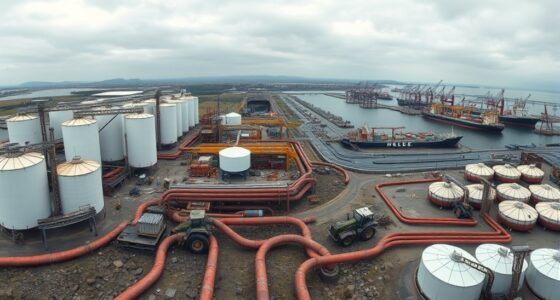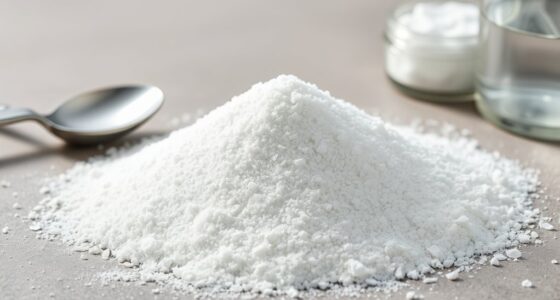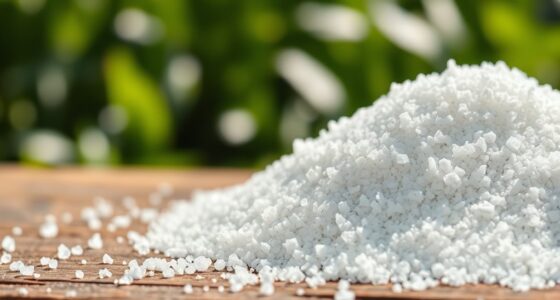Limestone plays a crucial role in many industrial chemical processes by serving as a key raw material for cement, steel, and glass production. It helps neutralize acids in water treatment and acts as a flux to remove impurities during smelting. Its high calcium carbonate content provides stability and efficiency during high-temperature operations. Interested in how limestone supports environmental sustainability and innovation? Keep exploring to discover more about its diverse industrial applications.
Key Takeaways
- Limestone serves as a raw material in cement production, undergoing calcination to produce clinker and release CO₂.
- It acts as a flux in steelmaking, removing impurities and aiding in the conversion of raw iron ore to steel.
- Limestone is used in flue gas desulfurization to neutralize sulfur dioxide emissions and produce gypsum.
- It provides alkalinity and buffering in chemical processes, stabilizing pH and improving reaction efficiency.
- Limestone contributes to sustainable practices by enhancing process efficiency and reducing environmental impacts in industrial applications.
Composition and Properties of Limestone

What exactly is limestone made of, and what makes it suitable for industrial use? Limestone primarily consists of calcium carbonate, which gives it its chemical and physical properties. Its high calcium carbonate content makes it versatile in various processes. However, limestone isn’t pure; it often contains mineral impurities like clay, silica, and iron oxides. These impurities can influence its strength, color, and reaction behavior during processing. The mineral impurities vary depending on the source, affecting how limestone performs in different applications. Its durability, ease of excavation, and natural abundance make it an ideal raw material for industries. The calcium carbonate content ensures it reacts predictably in chemical processes, while impurities are carefully managed to optimize its industrial usefulness. Additionally, the presence of automated logistics in the industry has facilitated the transportation and processing of limestone on a large scale.
Limestone in Cement Manufacturing
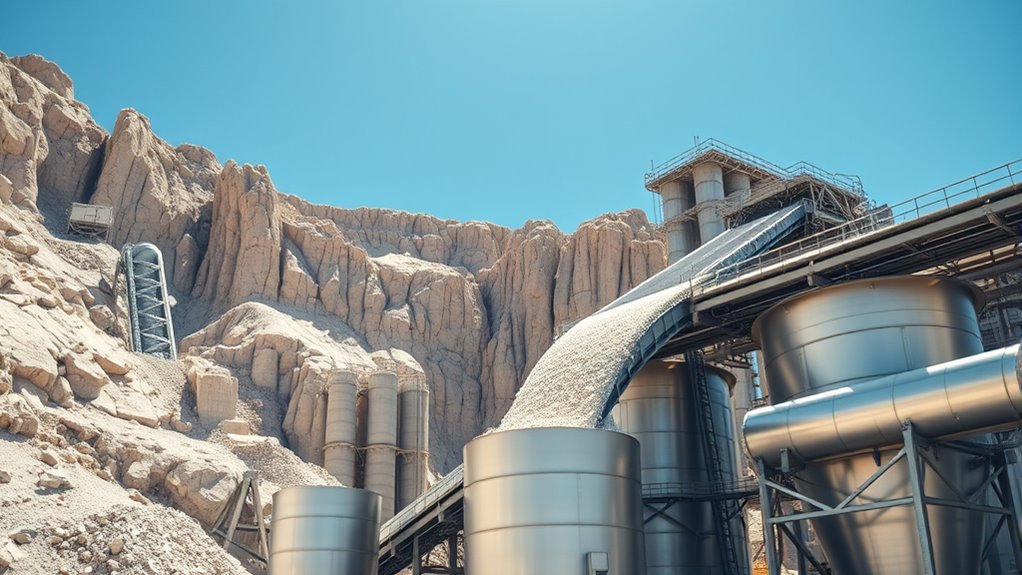
Have you ever wondered how limestone transforms into the cement that holds buildings together? It all begins with limestone quarrying and limestone mining, where large deposits are extracted. Once mined, limestone is crushed and heated in a kiln to produce clinker, the key ingredient in cement. This process involves calcination, which releases carbon dioxide and transforms calcium carbonate into calcium oxide. The clinker is then ground with gypsum to create cement. Here’s a quick overview:
| Step | Description |
|---|---|
| Limestone quarrying | Extracting limestone from earth’s surface |
| Limestone mining | Underground extraction of limestone |
| Calcination | Heating limestone to remove CO₂, producing lime |
| Cement grinding | Blending clinker with additives to make cement |
This sequence turns raw limestone into the essential binder used worldwide.
Role in Steel Production and Metallurgy
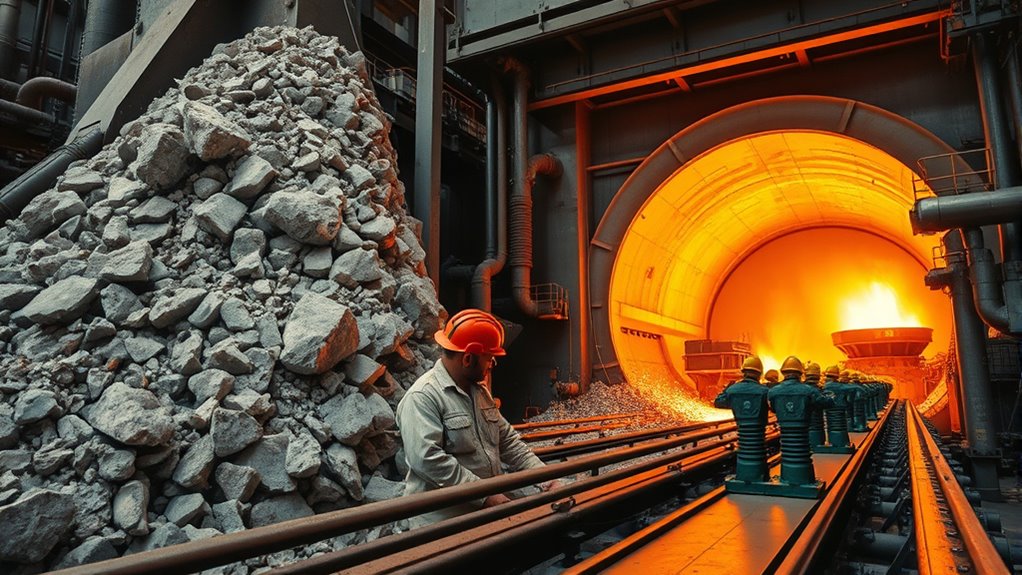
Limestone plays a crucial role in steel production and metallurgy by serving as a flux to remove impurities during smelting. It helps transform raw iron ore into usable steel by combining with silica, phosphorus, and sulfur, forming slag that can be easily separated. Beyond industrial use, limestone in art showcases its aesthetic appeal, while limestone in landscaping highlights its versatility. Additionally, the presence of limestone can influence the overall metal quality during the manufacturing process.
Use as a Neutralizing Agent in Water Treatment
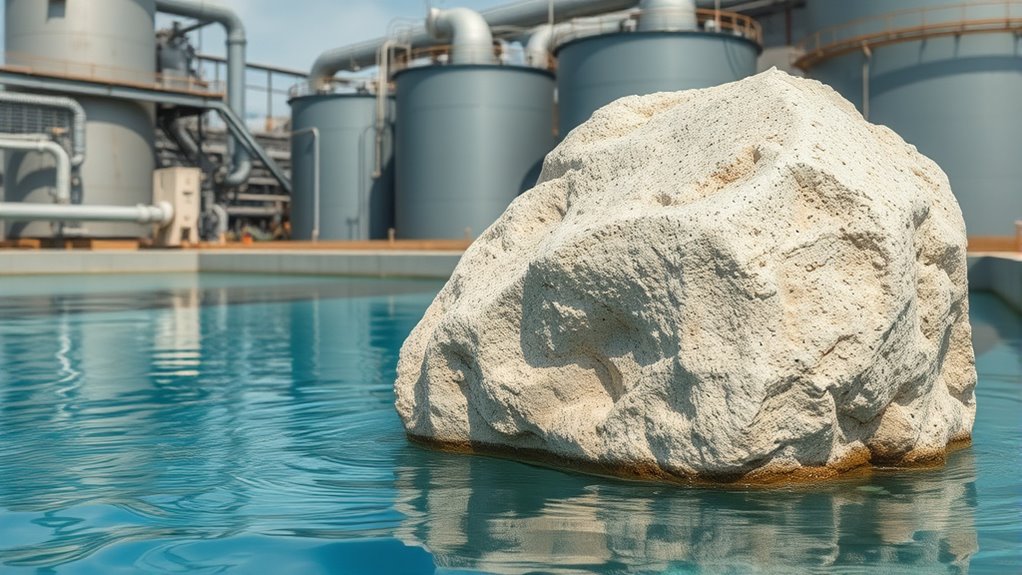
Limestone helps regulate pH levels in water treatment, making the process more effective and environmentally friendly. It also efficiently removes contaminants like heavy metals and organic matter, improving water quality. Plus, using limestone is a cost-effective option for large-scale treatment systems, saving money without sacrificing performance. Additionally, the signs of spoilage in related substances highlight the importance of proper handling and quality control in chemical processes. Recognizing trust issues and addressing them can further enhance the reliability of water treatment outcomes. The natural composition of limestone allows it to act as a natural buffering agent, balancing pH levels and stabilizing the water chemistry effectively.
Ph Regulation Benefits
Because of its natural ability to neutralize acids, limestone plays a crucial role in regulating pH levels during water treatment. Its pH stabilization helps maintain balanced water conditions, preventing harmful fluctuations that can affect ecosystems and equipment. When you add limestone, it effectively performs acid neutralization, ensuring contaminants don’t cause acidity issues. Additionally, the mineral’s color accuracy can influence the visual assessment of water quality during treatment processes. This process offers several benefits:
- Consistent water quality
- Reduced corrosion risks
- Enhanced safety for aquatic life
- Lower chemical treatment costs
- Regular use may lead to notable improvements in overall water stability.
Contaminant Removal Efficiency
Have you ever wondered how effectively limestone neutralizes contaminants during water treatment? Its mineralogy plays a vital role, as calcium carbonate reacts with acids and pollutants. Contaminant detection techniques, such as pH testing and ion chromatography, help evaluate removal efficiency. The mineral structure influences how quickly and completely contaminants like heavy metals or nitrates are neutralized. For example:
| Contaminant Type | Limestone Reaction | Detection Technique |
|---|---|---|
| Heavy Metals | Precipitation | Spectrophotometry |
| Nitrates | Adsorption | Ion Chromatography |
| pH Adjustment | Neutralization | pH meters |
Understanding limestone’s mineralogy guarantees ideal contaminant removal, making it a reliable neutralizing agent in water treatment processes. Additionally, the presence of impurities within limestone can impact its overall effectiveness in contaminant removal. Community feedback helps identify the most effective practices for optimizing contaminant removal efficiency, as geological composition can significantly influence performance.
Cost-Effective Treatment
Utilizing limestone as a neutralizing agent in water treatment offers a cost-effective solution for removing acidity and certain pollutants. Its affordability stems from its abundant availability and straightforward mineral extraction process, which reduces overall treatment costs. This approach not only mitigates the need for expensive chemicals but also positively impacts the local economy by creating jobs and supporting sustainable practices. When you use limestone, you benefit from its natural buffering capacity, making water safer for industrial, agricultural, and municipal use. Additionally, Kia Tuning techniques can be employed to optimize the chemical process for specific water treatment needs, enhancing efficiency and outcomes. Moreover, understanding the digital literacy of operators can improve the effectiveness of limestone-based treatment methods. Recognizing the AI Security considerations involved in monitoring and controlling water treatment systems can further enhance safety and reliability.
Application in Glass and Ceramic Industries
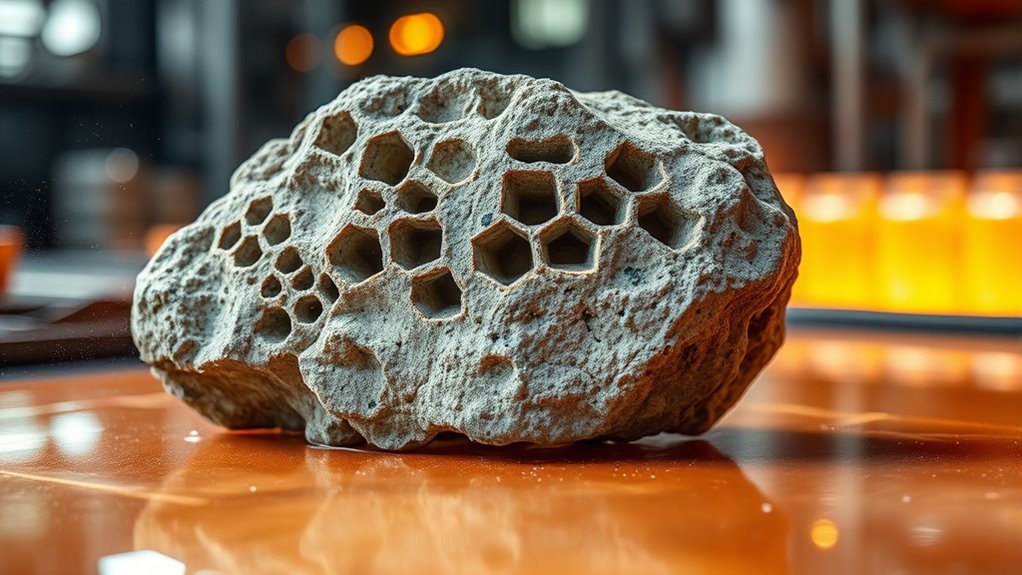
Limestone’s raw material composition greatly affects its suitability for glass and ceramic production, especially regarding purity and calcium content. Its melting point influences how easily it integrates into high-temperature processes, ensuring consistent quality. To maintain product standards, strict quality control measures are essential during limestone selection and processing.
Raw Material Composition
What makes limestone so valuable in the glass and ceramic industries is its specific chemical composition. Its consistent mineral purity guarantees reliable results during production, while its geological formation influences its purity levels. High-quality limestone contains mainly calcium carbonate, with minimal impurities that could affect the final product. Additionally, understanding and controlling emotional needs during the manufacturing process can help optimize quality and reduce waste.
Key factors include:
- Mineral purity, ensuring minimal contaminants
- Consistent calcium carbonate content
- Limited impurities from geological formation
- Ability to produce uniform raw materials
These attributes allow you to create high-quality glass and ceramic items, as the limestone’s composition directly impacts melting behavior and final strength. Selecting limestone with the right chemical makeup guarantees process efficiency and product durability, making it an essential raw material.
Melting Point Influence
How does limestone’s melting point influence its role in glass and ceramic manufacturing? The melting point influence determines how limestone behaves during high-temperature processes. As limestone has a relatively high melting point, it acts as a stable filler and flux, reducing melting temperatures when added to raw mixtures. Its thermal conductivity affects heat transfer efficiency within furnaces, impacting energy consumption and process control. A consistent melting point ensures predictable behavior during firing, helping to achieve desired product qualities. If limestone melts too early or too late, it can cause defects or energy inefficiencies. Additionally, thermal stability is crucial for maintaining consistent performance at high temperatures. Understanding limestone’s melting point influence allows you to optimize firing conditions, improve product consistency, and control thermal properties essential in glass and ceramic production.
Quality Control Measures
Effective quality control measures are essential in the glass and ceramic industries to guarantee consistent product performance and safety. To achieve this, you must monitor limestone quality throughout extraction and transportation. Ensuring proper limestone extraction minimizes impurities that could compromise final products. During limestone transportation, maintaining proper conditions prevents contamination and degradation. Key measures include:
- Regular testing of limestone for purity and composition
- Strict inspection during limestone transportation
- Calibration of raw material input based on test results
- Continuous monitoring of storage conditions
These steps help identify defects early, reduce waste, and guarantee the limestone used meets industry standards. Implementing rigorous quality control protocols in extraction and transportation processes secures the consistency and safety of glass and ceramic products, ultimately boosting your quality assurance efforts.
Limestone in Flue Gas Desulfurization
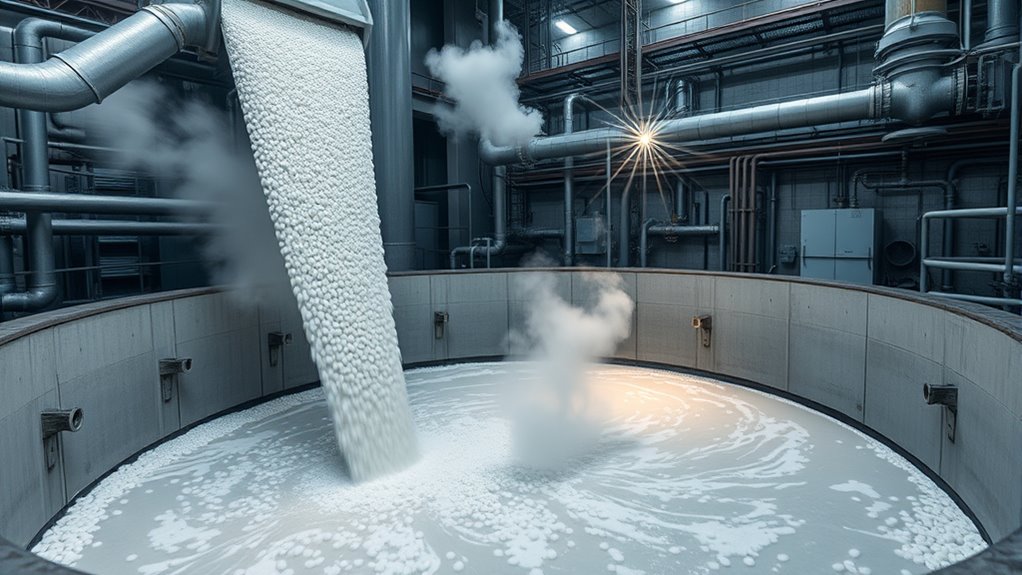
Limestone plays a crucial role in flue gas desulfurization (FGD) processes by removing sulfur dioxide (SO₂) from emissions produced by fossil fuel combustion. To prepare limestone for FGD, you start with limestone quarrying, where raw material is extracted from the earth. The limestone then undergoes beneficiation, a process that improves its purity and particle size for maximum reaction efficiency. Proper beneficiation removes impurities like silica and alumina, ensuring the limestone effectively reacts with SO₂. In FGD systems, finely ground limestone is sprayed or circulated to absorb sulfur dioxide, forming calcium sulfate or gypsum as a byproduct. This process helps reduce air pollution and complies with environmental regulations while utilizing limestone’s natural chemical properties. Additionally, understanding market research can help optimize the selection and processing of limestone for specific industrial applications. Moreover, the efficiency of the desulfurization process depends significantly on the quality and particle size of the limestone used. Implementing precise control over particle size distribution enhances the overall effectiveness of sulfur dioxide removal.
Importance in Paper and Pulp Processing
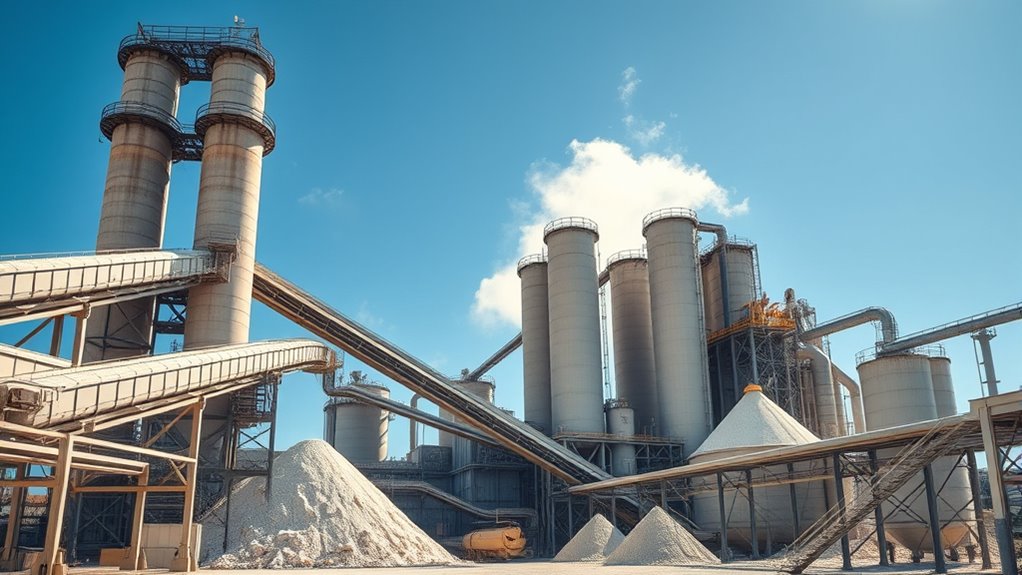
Have you ever wondered why limestone is an essential ingredient in paper and pulp processing? Its significance lies in its chemical and physical properties, which help refine pulp and improve paper quality. Limestone fossilization over millions of years creates high-purity deposits, ideal for industrial use. When quarrying limestone, techniques like blasting and cutting ensure minimal environmental impact and high efficiency. In paper manufacturing, limestone helps neutralize acidity, enhances brightness, and improves paper strength. Its calcium carbonate content acts as a filler, increasing opacity and smoothness. Proper quarrying methods ensure consistent quality, making limestone indispensable in producing high-grade paper products. Additionally, understanding quarrying techniques can help optimize the extraction process and maintain sustainable practices in limestone use, reducing environmental impact while supporting industrial needs.
Utilization in Agriculture and Soil Conditioning

Limestone plays an essential role in agriculture by helping you regulate soil pH and improve nutrient availability. When applied, it neutralizes acidity and boosts the efficiency of fertilizers. This makes your soil healthier and more productive for crops. Additionally, proper use of agricultural limestone can enhance overall soil quality and promote sustainable farming practices. Utilizing the right type of limestone ensures effective carb tracking and nutrient absorption, ultimately supporting healthier crop growth.
Soil Ph Regulation
Because soil pH greatly influences plant growth and nutrient availability, managing it effectively is essential for successful agriculture. Limestone helps with pH stabilization by neutralizing soil acidity, making nutrients more accessible to plants. This natural remedy is commonly used to improve soil health and optimize crop yields. When you add limestone, you’re actively reducing soil acidity, creating a more favorable environment for plant roots.
You should consider:
- Adjusting soil pH for specific crops
- Preventing nutrient deficiencies linked to acidity
- Enhancing soil structure and aeration
- Promoting beneficial microbial activity
Nutrient Supply Enhancement
Did you know that limestone plays a crucial role in enhancing nutrient availability in soils? Its influence on limestone geochemistry helps improve soil structure and mineral content, making nutrients more accessible to plants. By using bioremediation techniques, you can apply limestone to contaminated soils to neutralize acidity and stimulate microbial activity, which further promotes nutrient cycling. Limestone’s ability to buffer pH levels creates ideal conditions for nutrient uptake, especially in acidic soils. This process not only boosts crop yields but also improves soil health over time. When you incorporate limestone into soil conditioning practices, you’re leveraging its natural properties to enhance nutrient supply sustainably. Understanding limestone geochemistry allows you to optimize its benefits for agriculture and soil fertility.
Acid Neutralization Effects
When you apply limestone to acidic soils, it effectively neutralizes excess acidity, creating a more balanced environment for plant growth. This process relies on limestone’s ability to provide pH buffering, helping maintain stable soil pH levels. It’s especially useful in counteracting the effects of acid precipitation, which can lower soil pH over time. By neutralizing acids, limestone improves nutrient availability and reduces soil toxicity.
- Enhances soil stability and structure
- Prevents nutrient leaching caused by acidity
- Promotes healthy root development
- Extends the soil’s capacity to buffer future acid inputs
Using limestone for acid neutralization supports sustainable agriculture and soil health, ensuring plants thrive despite environmental challenges.
Environmental Benefits and Sustainable Practices
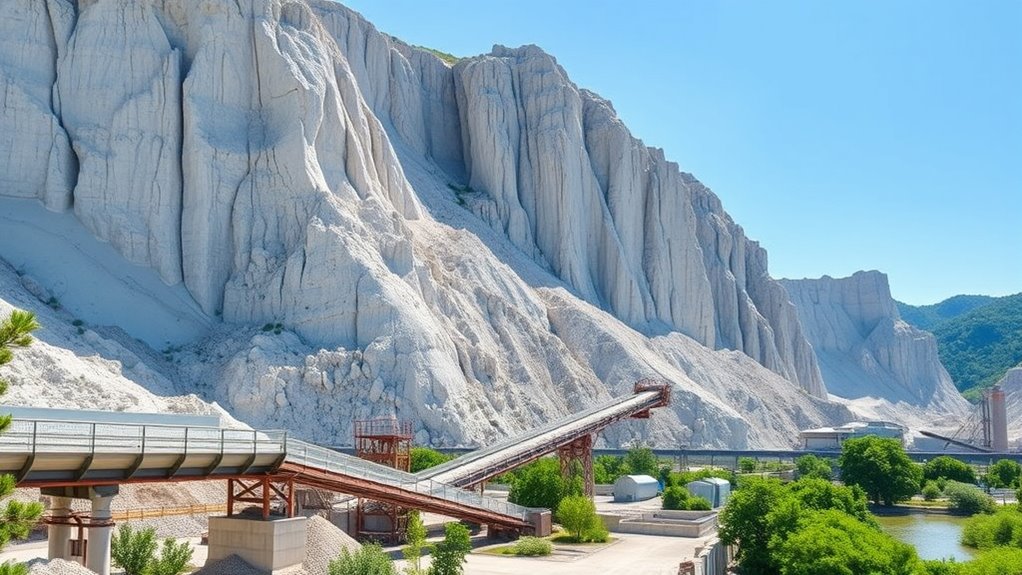
Limestone production can offer significant environmental benefits when sustainable practices are prioritized. Its mineralogy allows for efficient extraction with minimal waste, reducing overall environmental footprint. By implementing eco-friendly mining techniques, you can lower energy consumption and reduce emissions. Reusing crushed limestone in construction and agriculture further promotes sustainability. To understand the impact, consider this table:
| Practice | Benefit | Impact |
|---|---|---|
| Eco-friendly mining | Reduces habitat destruction | Lowers environmental footprint |
| Recycling crushed limestone | Minimizes waste and resource use | Decreases landfill accumulation |
| Low-energy processing | Cuts carbon emissions | Lessens overall environmental impact |
| Sustainable quarry management | Preserves local ecosystems | Protects biodiversity |
| Use of limestone mineralogy | Maximizes extraction efficiency | Reduces resource depletion |
Future Trends and Innovations in Limestone Utilization
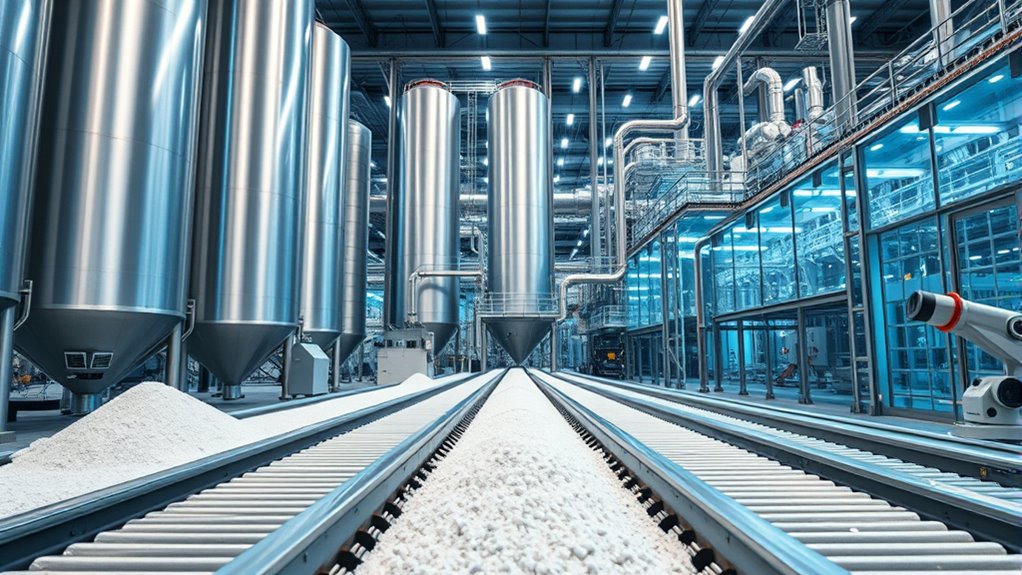
As technological advancements continue, innovative methods are emerging to enhance limestone utilization across industries. Understanding limestone mineralogy allows for better extraction and processing techniques, boosting efficiency. Future trends include developing eco-friendly calcination methods that reduce energy consumption and emissions. You’ll also see increased use of limestone in carbon capture and storage, aligning with sustainable goals. The economic impact is significant, as improved extraction and processing lower costs and open new markets. Additionally, advancements in nanotechnology enable the creation of high-performance limestone composites for construction and manufacturing.
- Enhanced mineralogical analysis improves resource recovery
- Green calcination reduces environmental footprint
- Limestone-based carbon capture boosts sustainability
- Nanotech applications expand product capabilities
Frequently Asked Questions
How Does Limestone Influence Chemical Reaction Rates in Industrial Processes?
You might wonder how limestone influences chemical reaction rates. Limestone can have catalytic effects, often acting as a catalyst or providing a surface that speeds up reactions. This impacts reaction kinetics by lowering activation energy, making processes more efficient. In industrial processes, using limestone accelerates reactions, reduces energy consumption, and enhances productivity, ultimately optimizing the overall chemical reaction rates.
What Are the Environmental Impacts of Limestone Quarrying?
Imagine the quiet sites where limestone is quarried—soon disrupted by environmental degradation and habitat disruption. You might not see it, but quarrying can cause soil erosion, water pollution, and loss of biodiversity. This environmental impact threatens ecosystems and communities. As you consider limestone’s industrial uses, remember the hidden costs; quarrying isn’t just about extraction—it alters landscapes and endangers wildlife, leaving a lasting mark on our environment.
Can Limestone Be Recycled or Reused in Industrial Applications?
Limestone can be recycled and reused in various industrial applications, making it a sustainable choice. You can often repurpose limestone waste or by-products through limestone recycling processes, reducing environmental impact. Limestone reuse is common in construction, agriculture, and even in the production of cement. By reusing limestone, you help conserve resources and minimize waste, supporting eco-friendly practices across industries.
How Does Limestone Purity Affect Its Performance in Chemical Processes?
Think of limestone as the backbone of many processes; its purity directly influences performance. When limestone mineralogy is high in calcium carbonate, it reacts more efficiently, reducing impurities that cause unwanted byproducts. A purity assessment helps guarantee consistent results. For example, in cement production, high-purity limestone yields stronger, more durable concrete. If you compromise purity, you risk process inefficiencies and lower quality outcomes, so always verify limestone’s purity before use.
Are There Alternative Materials to Limestone for Specific Industrial Uses?
You might wonder if there are alternative materials to limestone for certain industrial uses. Yes, options like dolomite, marble, or synthetic calcium carbonate can sometimes replace limestone. When choosing alternatives, consider cost factors, availability, and chemical properties. These materials can offer different advantages or suit specific processes better, but you need to weigh their costs and performance to determine the best fit for your industrial application.
Conclusion
Limestone plays a crucial role across many industries, transforming raw materials into essential products. Its versatility and environmental benefits make it a sustainable choice for the future. As you consider its applications, ask yourself—can we afford to ignore such a valuable resource that supports both industry and the planet? Embracing innovative uses of limestone can pave the way for a greener, more sustainable tomorrow. So, will you be part of this positive change?
